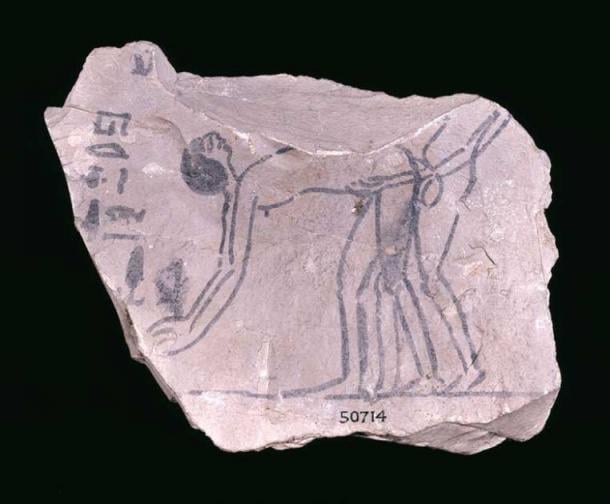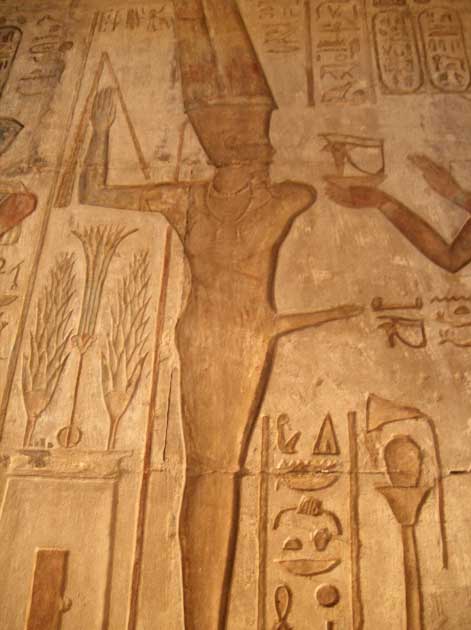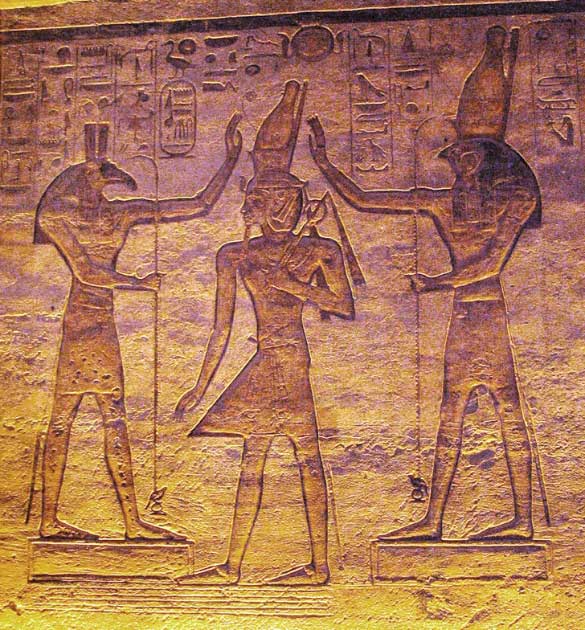People often have the strange idea that people in the “olden days” were much more conservative when it came to sex than they are today. However, if modern history tells us anything it is that people still have weird hang-ups when it comes to sex. Now, more than ever, our headlines are full of stories about what people like to get up to behind closed doors. If we take a look back at our ancestors we often find that if anything they were much more open-minded than we are in this day and age. Sex in ancient Egypt is a prime example.
×

Fragment of a limestone ostracon excavated at Deir el-Medina, Thebes, depicting a sex scene in ancient Egypt. (The British Museum / CC BY-NC-SA 4.0 )
Depictions of Sex in Ancient Egypt
When looking at how a civilization viewed sex, a good starting point is often to look at their artwork. How did artists depict sex? How prominently displayed was graphic artwork? From these kinds of sources, we can learn more intimate details, such as which positions were popular, which acts were socially acceptable, or more about general attitudes towards sex.
When it comes to Egyptian artwork one could be forgiven for thinking they were all prudes. In Egyptian artwork, the act itself is rarely explicitly detailed. Instead, it is often just alluded to. A possible reason for this is that the artwork was prominently displayed in tombs and temples. It may just be that they kept the artwork vanilla as a sign of respect and to avoid any desecration of holy spaces.
When Egyptian artwork did get graphic, they often used workarounds. For example, one or more of the parties would be replaced with an image of an animal. Or they would use visual euphemisms instead.
A classic example is in one image in which an Egyptian King Tutankhamen is shown sitting on a chest handling his “bow.” His wife is standing by him, arrow ready, while Tutankhamen is poised ready to shoot. This is significant because in ancient Egyptian the word for “shoot” is the same as to ejaculate. Safe to say the image wasn’t necessarily about Tutankhamen practicing his archery skills.
Of course, this aversion to erotic artwork does not mean there is none to be found. The ancient Egyptians were famously adept at building impressive monuments and it would appear it has always been human nature to scrawl something rude on the side of big buildings. There is a famous example of sexually explicit graffiti showing Hatshepsut and Senenmut enjoying each other’s company.
The Turin Erotic Papyrus: The Ancient Egyptian Playboy
Besides examples of rude graffiti, we also have the Turin Erotic Papyrus . The Turin Papyrus dates back to around 1150 BC but wasn’t discovered until the start of the 19th Century. It has been described as the world’s first men’s magazine. Think of it as an ancient Egyptian Playboy.
The Turin Erotic Papyrus shows a mixture of people, animals, or both in a series of different sexual acts and positions. Historians can’t seem to agree on the purpose of the document. Some claim it’s a work of satire, made to mock the human obsession with sex and at the same time Egyptian prudishness. It is also claimed the Turin Erotic Papyrus is aimed at mocking the hedonistic upper class.
Some historians go as far as to say it’s a record of the actions between a prostitute and her rich client. We know that Egyptians would sometimes use animal imagery when depicting sex for modesty’s sake, so here it is asserted that the animal imagery was used to save the supposed client’s modesty. Yet this doesn’t seem applicable to a document that already depicts humans in the act.
There are, however, experts who aren’t convinced by this argument. Instead, they take the view that if it looks like pornography, it probably is pornography, hence the men’s magazine analogy. Of course, it could be both. A work of satire designed to not just mock, but titillate too. The existence of this kind of sexually explicit artwork appears to show that ancient Egyptians were not prudes at all. In fact, in many ways, they were pretty liberal when it came to sex. Much more so than many people today.

The Turin Erotic Papyrus has become famous due to its erotic content. An ancient Egyptian papyrus scroll-painting dating back to about 1150 BC, it was discovered at Deir el-Medina in the 19th century and was found to include various erotic vignettes which show sex positions. It is now on display at Museo Egizio in Turin. (Museo Egizio / CC BY 2.0 IT )

While the original is in a poor state of conservation, experts have reconstructed its content. This is a segment of the erotic scenes within the reconstructed papyrus. ( Tatiana Gorbutovich / Fair Use )
The Ancient Egyptian Approach to Virginity
A common feature of more recent history is a certain obsession with virginity and purity. Of course, this ties in with the dominant religions of recent times. After all, Christianity is a religion that is founded on the idea of an immaculate birth. Even today the idea of sex before marriage is frowned on in much of the world, both developing and developed. Yet it hasn’t always been this way. Different ancient civilizations had different approaches to virginity.
For ancient Egyptians virginity was a complete non-issue and losing one’s virginity wasn’t a big deal. It was completely normal for people to have sex before marriage. In short, if you were young and single, you were free to hook up with whoever you liked. With one caveat. The other party must be unmarried too.
The ancient Egyptians may not have cared about sex before marriage, but once you were in committed relationship adultery was a big no-no. This indifference towards virginity is best summed up by the fact they didn’t have a word for virgin or virginity. The concept simply doesn’t seem to have existed.

A painted relief depicting the Egyptian god Min at Deir el-Medina. (Institute for the Study of the Ancient World / CC BY 2.0 )
Divine Masturbation: Self-Pleasure in Ancient Egypt
Another hang-up that ancient Egyptians didn’t have was masturbation. These days we often don’t talk about masturbation in polite conversation, and if it does come up a young man is likely to be told that he’ll either go blind or that God is watching. Indeed a part of some modern religious beliefs is that masturbation is a sin. Sex is between a man and his wife, not a man and… himself. The ancient Egyptians would have tended to disagree. If anything the act of a man masturbating viewed as an almost divine act. Why? Because god did it too.
Ancient Egyptian religion is full of sex stories, some pretty bizarre. There are a few conflicting creation myths , but the one we’re concerned with features the creation god pleasuring himself. It has the first god (maybe Atum, maybe Ra depending on the era) creating himself. His first task as a god was to create the other deities.
As the only being in existence, he couldn’t exactly do this through fornication, so he masturbated and then spat out his offspring, Shu and Tefnut. They then went on to create more gods and goddesses. In short, according to ancient Egyptians, masturbation played a major role in birthing the world. So, of course it wasn’t something to be frowned upon.
But what about female masturbation? The answer to this question is a little less clear-cut. It is likely that once again it just wasn’t much of an issue. As there aren’t many historical references to it, it is likely it was accepted but just not talked about.
We do know that female masturbation is depicted on the Turin Erotic Papyrus which features a lady sitting on a vase as an act of masturbation. There is also the famous story of Cleopatra and the bees. To be 100% clear, this is a rumor and I could find no historical evidence to back it up. But since there’s usually no smoke without fire, the story is still relevant.
The story goes that Cleopatra had the world’s first sexual aid in the form of a rudimentary sex toy . It is claimed (but once again not verified) that she had either a hollowed-out gourd or an empty box full of bees. It is thought that the buzzing of these angry bees would make their container vibrate. The dots can be put together from there.

When excavating Tutankhamun’s tomb, archaeologists found a fine linen condom, which had been soaked in olive oil, and would have been attached to a string which tied around his waist. It dated back to 1350 BC. Experts are not sure if it was used for ritual purposes, to prevent disease or as a contraceptive method. ( Egypt Museum )
Contraception and Abortions – Not a Big Deal in Ancient Egypt
Sex in ancient Egypt was relatively safe. Contraceptives were neither uncommon nor taboo. Thanks to the Kahun Gynaecological Papyrus we actually have a good idea of what went into Egyptian contraception. It’s safe to say some of the recipes are pretty hard to stomach.
One example is the use of acacia tree sap which was used to “close the mouth of the womb.” This may sound like a good way to get a nasty infection, but there is some scientific evidence that this may have worked. The gum contains a known spermicide, lactic acid. Another, more worrying, form of contraception was a diaphragm made from crocodile dung, dates, acacia, and honey.
A quick Google search will show that the Egyptians had recipes for many different kinds of contraceptives. This doesn’t necessarily mean they were all effective. It is likely that for most women of the period these contraceptives just helped put off the inevitable.
The first recorded evidence of abortion also comes from ancient Egypt. The source is the Egyptian Ebers Papyrus from 1550 BCE. These abortions weren’t how we think of them today, however. Abortions tended to be non-invasive and non-surgical. Instead, herbal drinks, vaginal douches, and suppositories were used. Besides this, it was common to use strenuous physical activities, the kind doctors often advise pregnant women to avoid, to provoke a miscarriage.

The gods Seth (left) and Horus (right) adoring Ramesses in the small temple at Abu Simbel. The story of the gods Seth and Horus reveals details about the attitude to homosexuality in ancient Egypt. ( Public domain )
Attitudes to Homosexuality in Ancient Egypt
It would appear that the laissez-faire attitude to sex in ancient Egypt probably extended to sexual orientation, at least to some extent. Egyptian society in general appears somewhat hetero-normative. It was expected that people married young and, when ready, would start producing little ones. Marriage was taken seriously and large families were common.
There isn’t much information on homosexuality in ancient Egypt, but what we have shows that the attitude towards homosexuality was similar to that of ancient Greece. The evidence in question is the somewhat homoerotic story of the gods Seth and Horus.
Seth wanted to be the top god and, of course, there was only one reasonable way to do this. By forcefully fornicating with his top rival, Horus, to show his superiority and dominance. He planned to turn the other gods against Seth by showing him to be weak and womanly. His plan backfired when Isis stepped in, protected Horus and tricked Seth into eating Horus’s semen which put Seth in a submissive position.
What we can take from this is that ancient Egyptians had nothing against homosexuality in general. But it was one-sided. There was nothing wrong with being the active partner, but it was looked down upon to be the passive partner. In cruder terms, it was OK to give but not to receive.
On the other hand, the tomb of Niankhknum and Khnumhotep at Saqqara potentially paints a more enlightened view of homosexuality in ancient Egypt. Maybe. There is some disagreement about what the tomb represents, so let’s break it down.
The tomb at Saqqara is anomalous because it was so uncommon that two wealthy high-class men of the time would share a tomb. The artwork of the tomb shows the two men in close, and the intimate situations depicted certainly makes it look like they were very close indeed. Upon its discovery, some Egyptologists suggested that they were simply brothers. Perhaps even conjoined twins who had no option but to touch each other constantly.
This feels like a bit of a stretch. The walls of the tomb are indeed adorned with images of the two men’s wives and multiple offspring. So maybe they were two straight, heterosexual, married, bosom buddies. However, it is also true that the walls feature the men holding each other in a manner usually only used to depict heterosexual couples. This depiction of the two men is incredibly odd if they were merely friends or brothers.
It seems entirely possible that the two men were either gay or bisexual and that they were in a romantic relationship with each other whilst also having children with their wives. It is also entirely possible that this is an early example of polyamory. Whichever way you cut it seems incredibly heteronormative to ignore the signs and paint the two men as two extremely, and arguably unusually, close brothers and leave it at that.

Mastaba joint tomb depicting Niankhkhnum and Khnumhotep embracing one another. The two men are speculated to be lovers, although some Egyptologists argue that they may have been brothers or twins. (Kairoinfo4u / CC BY-NC-SA 2.0 )
This is not to say that it is all sunshine and rainbows when it comes to sex in ancient Egypt . For a start, there is evidence to say that while frowned upon, neither bestiality nor necrophilia was exactly uncommon. There are several religious tales in ancient Egypt that feature both. It would seem that rather than take these tales as the allegories, it was actually quite common for some people to indulge their most base impulses. Reportedly it was so bad that they sometimes had to delay delivering the more attractive corpses to the embalmers for mummification, just in case.
There is also evidence that their approach to adultery was a little uneven. Women were supposed to hold equal standing to men but unsurprisingly it appears that it was more acceptable for the husband to play away from home than the wife. Also unsurprisingly, the richer you were, the less frowned upon it was.
On the whole, there is a lot of good we can learn from the ancient Egyptian approach to sexuality. They accepted that at their core people are sexual beings. Religion was used to encourage this, not discourage it. Sex was a divine and beautiful, but also normal, part of everyday life, and not something to be avoided.
Thousands of years ago the Egyptians were taking for granted the very freedoms that many people are still fighting for today. And what of the many of the prejudices that people face every day? They didn’t even exist. Of course, we should never look at history through rose-tinted glasses, but it would seem there’s a lesson to be learned here.
Top image: Some information can be gathered about sex in ancient Egypt by viewing scenes from the mastaba tomb of Khnumhotep and Niankhkhnum at Saqqara in Egypt. Source: Sailingstone / Adobe Stock
By Robbie Mitchell
Source: ancient-origins.net








